Medical disclaimer: This article is for informational purposes only and does not replace professional veterinary advice. Always consult your veterinarian before starting treatment.
Table of Contents
Does your dog keep scratching, licking, or getting ear infections? You’re not alone—dog allergies are one of the most common reasons pet owners visit the vet. As a veterinarian in Ottawa, I’ve seen hundreds of dogs with itchy skin, upset stomachs, and red, irritated ears. Many of them suffered for months before getting a diagnosis. The good news? With the right plan, most allergic dogs can live a happy, itch-free life. This guide covers what dog allergies are, how to recognize them, and the best treatments—based on veterinary science and real clinic experience.
🔑 Key Takeaways: Dog Allergies at a Glance
- Dog allergies are extremely common and usually affect the skin, ears, or digestive system. Itching, paw licking, and recurrent ear infections are key warning signs.
- The main types of dog allergies include food allergies, flea bite reactions, environmental triggers (like pollen or dust), and contact allergies.
- Diagnosing dog allergies involves ruling out other causes, running an elimination diet, or testing for environmental allergens.
- Treatments include medications (like Apoquel or Cytopoint), flea control, dietary changes, immunotherapy, and topical care.
- Managing your dog’s environment—clean bedding, HEPA filters, and routine bathing—can make a big difference in allergy control.
- Always consult your vet before starting treatments or changing your dog’s diet. A proper diagnosis is the first step to lasting relief.
What Are Dog Allergies?
Dog allergies happen when a dog’s immune system overreacts to everyday substances—like pollen, flea saliva, or certain food proteins.
These reactions can lead to itchy skin, ear infections, stomach issues, or all three. Allergies don’t just make dogs uncomfortable—they can affect their sleep, mood, and even their bond with you.
Some dogs are more prone to allergies than others. Breeds like golden retrievers, Westies, French bulldogs, and Labs often show signs early in life. Genetics play a role, but so do things like indoor air quality, flea exposure, and diet.
In my Ottawa practice, I’ve seen dogs improve quickly once we identify the right triggers. One bulldog patient, for example, had year-round ear infections until we switched him to a novel-protein diet and added Apoquel.
If your dog keeps scratching or gets repeat infections, it could be more than just dry skin. Dog allergies are manageable—but only with the right diagnosis and plan.
Types of Dog Allergies
Most dog allergies fall into four main categories. Knowing which type your dog has is key to choosing the right treatment.
1. Flea Allergy Dermatitis
This is the most common skin allergy in dogs. A single flea bite can trigger intense itching in sensitive dogs—especially around the tail, belly, and thighs.
Even indoor dogs can get fleas, so year-round flea prevention is essential. Products like Simparica Trio or Advantage II are safe and effective (ask your vet for guidance).
2. Environmental Allergies (Atopy)
These are caused by things in your dog’s surroundings—like pollen, dust mites, mold spores, or dander. Symptoms are often seasonal but can become year-round.
Dogs with atopy may lick their paws, rub their faces, or develop ear infections. Most start showing signs between 6 months and 3 years old.
3. Food Allergies
Dogs can become allergic to proteins in their food—commonly beef, chicken, lamb, eggs, or dairy. Symptoms usually include itchy skin, ear infections, and sometimes vomiting or diarrhea.
Food allergies are not seasonal. They require a strict elimination diet trial with a novel or hydrolyzed protein to diagnose.
4. Contact Allergies
These are less common but still possible. A dog may react to shampoos, cleaning products, certain plants, or materials like wool or rubber.
You’ll usually see redness or itchiness where the allergen touches the skin—such as paws or belly.
Each type of dog allergy may require a different treatment strategy. Some dogs even have more than one type at the same time.
Symptoms of Dog Allergies
Dog allergies show up in many ways, but most signs involve the skin, ears, or stomach. If your dog is constantly itchy or uncomfortable, allergies might be the reason.
Itchy Skin and Scratching
The most common sign of dog allergies is itchiness. Dogs may scratch, lick, or chew at their paws, belly, face, ears, or armpits.
You might notice red skin, scabs, hair loss, or “hot spots”—moist, irritated areas caused by chewing or licking.
Ear Infections
Chronic or recurring ear infections are a red flag. Look for head shaking, scratching at the ears, and foul-smelling brown or yellow discharge.
Many allergic dogs get yeast or bacterial ear infections—especially if the allergy isn’t well controlled.
Skin Changes
Allergies can lead to flaky, greasy, or thickened skin. Long-term scratching may cause dark patches or callused skin.
Some dogs also develop hives—raised, red welts that can appear suddenly.
Eye and Nose Issues
Some dogs with environmental allergies get watery eyes, sneezing, or reverse sneezing. These signs are more common during high pollen seasons.
Digestive Problems
Food allergies may cause vomiting, diarrhea, or frequent soft stools. These signs often go along with itchy skin or ear infections.
Facial Swelling and Hives
Some dogs have sudden swelling of the face, lips, or eyelids. This is usually caused by a sting or bite. Though scary-looking, it’s often not life-threatening unless breathing is affected.
If your dog shows these symptoms regularly, it’s time to talk to your vet. Dog allergies can be frustrating, but they’re treatable with the right plan.
How Vets Diagnose Dog Allergies
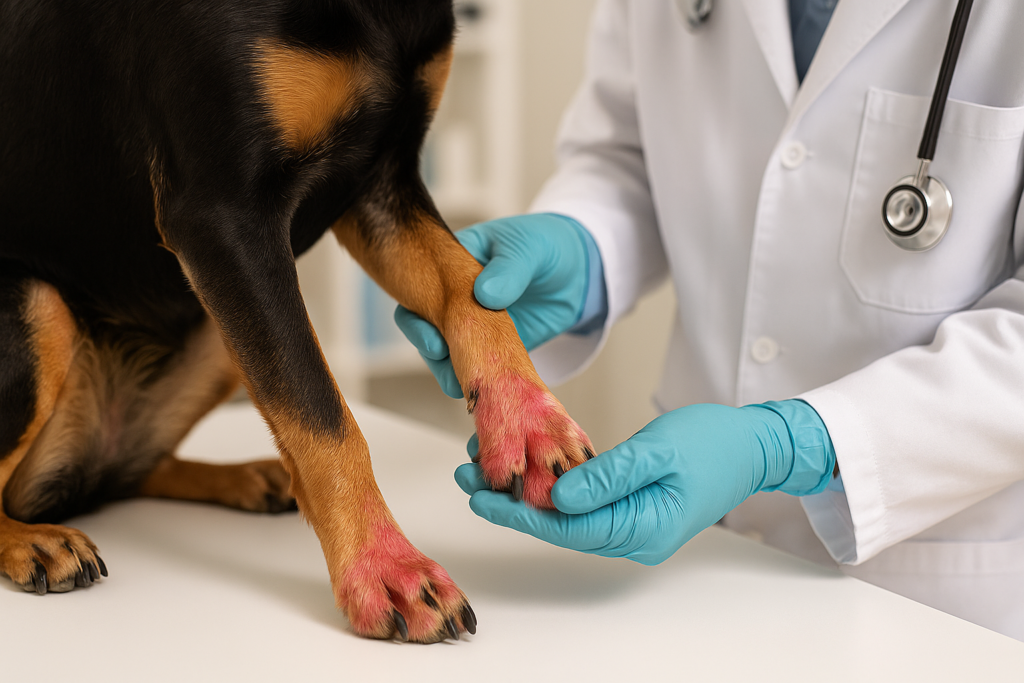
Diagnosing dog allergies isn’t always straightforward. Many skin and ear problems look the same on the surface. Your vet will follow a careful process to rule out other causes first.
You can also see: https://doglifeexpert.com/2025-top-benefits-of-agility-training-for-dogs/
Step 1: Physical Exam and History
Your vet will start with a thorough exam and ask questions about your dog’s symptoms. They’ll check for fleas, mites, or skin infections.
Sometimes they’ll perform a skin scrape, ear swab, or cytology test to check for bacteria, yeast, or parasites. These are common in itchy dogs, with or without allergies.
Step 2: Elimination Diet Trial
If a food allergy is suspected, your vet may recommend an 8–12 week diet trial.
This involves feeding only a hypoallergenic or novel-protein diet—like fish or rabbit—with no treats, table food, or flavored medications. If the symptoms go away, it suggests a food allergy.
This is the most reliable way to diagnose food-related dog allergies. Blood tests for food sensitivity are not dependable.
Step 3: Allergy Testing
If environmental allergies are suspected, testing can identify specific triggers.
- Blood tests check for antibodies to common allergens like pollen or dust mites.
- Intradermal skin testing, done by a dermatologist, is more accurate. Small amounts of allergens are injected under the skin to see if a reaction occurs.
Testing is usually done to prepare for immunotherapy, not to confirm if your dog has allergies.
Step 4: Response to Treatment
Sometimes, the vet will try a medication trial. If your dog improves dramatically on a drug like Apoquel or Cytopoint, it supports an allergy diagnosis.
This approach is helpful when testing isn’t available or while you wait for results.
Diagnosing dog allergies takes time and teamwork—but it’s the first step to lasting relief.
7 Vet-Approved Treatments for Dog Allergies
Treating dog allergies usually takes a combination of therapies. What works best depends on your dog’s allergy type and severity. Here are seven proven treatment options vets commonly use:
1. Flea Control
If your dog has flea allergy dermatitis—or even if you’re unsure—flea prevention is essential. One flea bite can cause a major reaction.
Use vet-approved products like Simparica Trio, NexGard, or Bravecto monthly. Don’t forget to treat your home and other pets, too.
2. Medications
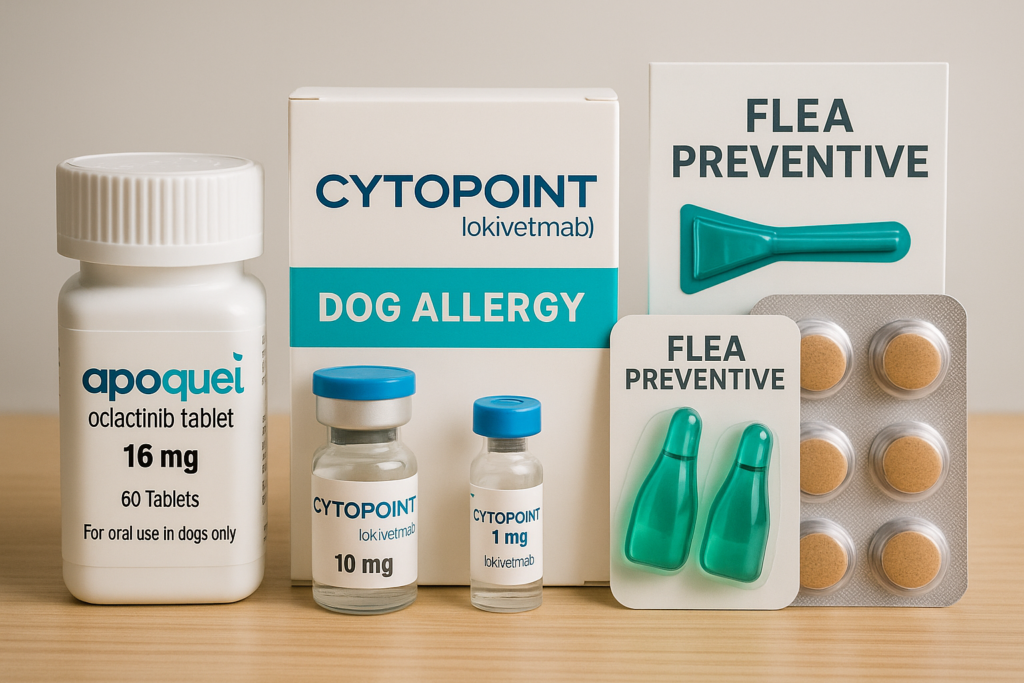
Several safe and effective medications relieve allergy symptoms:
- Apoquel (oclacitinib): Fast-acting oral tablet that targets the itch pathway.
- Cytopoint (lokivetmab): Monthly injection that blocks itch signals for 4–8 weeks.
- Steroids: Prednisone or dexamethasone provide fast relief but aren’t ideal long-term.
- Antihistamines: Benadryl or Reactine help some dogs but aren’t always effective.
- Antibiotics/Antifungals: These treat secondary infections caused by scratching.
Ask your vet which medication suits your dog’s case best.
3. Hypoallergenic Diet
If food allergies are involved, your dog may need a special diet with a novel or hydrolyzed protein.
Examples: Royal Canin Hypoallergenic, Purina Pro Plan HA, or Hill’s z/d. Always do diet trials under vet supervision.
4. Immunotherapy (Allergy Shots or Drops)
If testing finds specific environmental allergens, your vet may recommend a custom-made desensitization serum.
Your dog gets tiny doses over time to “train” the immune system. Results take 6–12 months, but over half of dogs improve significantly.
AAHA Canine Atopic Dermatitis Guidelines.
5. Medicated Baths
Frequent baths (every 1–2 weeks) with a vet-recommended shampoo can reduce allergens and soothe the skin.
Look for products with oatmeal, chlorhexidine, or ceramides. Bathing helps especially during high pollen season.
6. Topical Relief
Hydrocortisone sprays, wipes, or mousses can calm localized itchiness. They’re great for hot spots, itchy paws, or belly rashes.
Always check with your vet before using over-the-counter creams.
7. Supplements
Fish oil (omega-3s) helps reduce inflammation and supports skin health. Brands like Welactin or Grizzly Salmon Oil are often recommended.
Some vets may also suggest probiotics or skin barrier supplements.
Managing dog allergies is usually an ongoing process. The best plan often combines multiple treatments to keep your dog comfortable.
Managing Dog Allergies at Home
Once you’ve started treatment, your home environment plays a big role in controlling dog allergies. These practical steps can reduce allergens and prevent flare-ups.
Grooming and Bathing
- Bathe your dog every 1–2 weeks with a vet-recommended, soothing shampoo.
- Wipe paws and bellies with a damp cloth after outdoor walks to remove pollen and dust.
- Brush regularly to remove allergens trapped in the coat.
- Trim fur around the paws and belly to keep these areas clean.
Keep a Clean Living Space
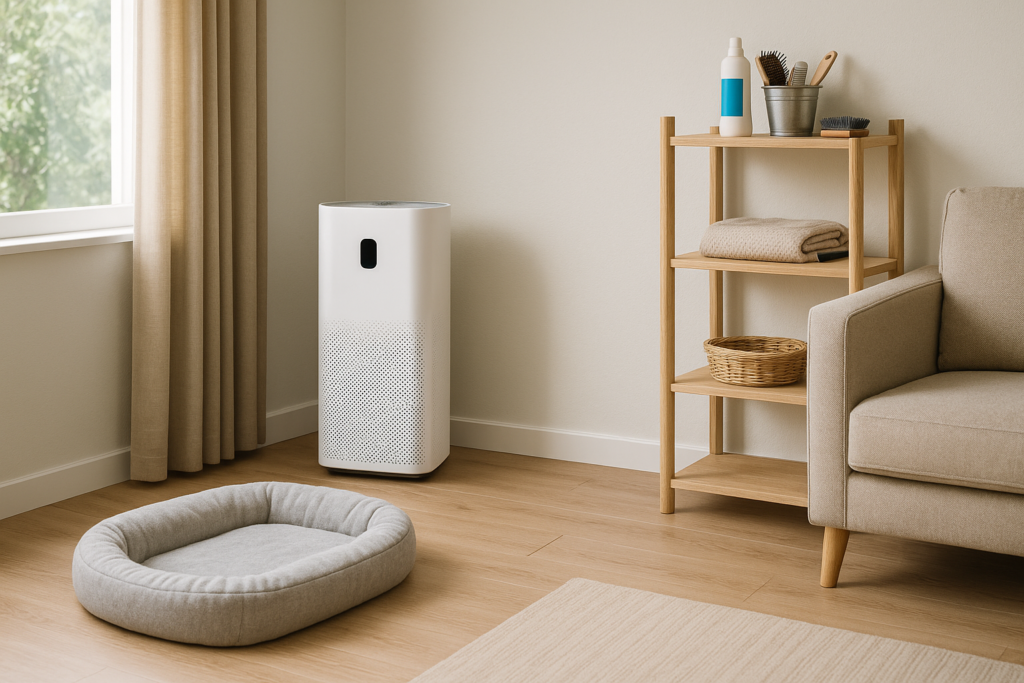
- Vacuum floors and furniture weekly using a HEPA-filter vacuum.
- Wash your dog’s bedding and toys weekly in hot water.
- Use air purifiers with HEPA filters in rooms your dog spends time in.
- Reduce carpets and heavy drapes that trap allergens.
Control Fleas Year-Round
- Use monthly flea prevention—even in winter.
- Treat all pets in the home, not just the allergic one.
- Clean your dog’s sleeping area and home often.
- Check your dog regularly for flea dirt or signs of bites.
Reduce Outdoor Allergen Exposure
- Limit walks during peak pollen times (early morning, evening).
- Avoid fields or grassy areas during allergy seasons.
- Keep windows closed during high pollen days.
- Try walking on sidewalks instead of grassy trails.
Diet and Supplements
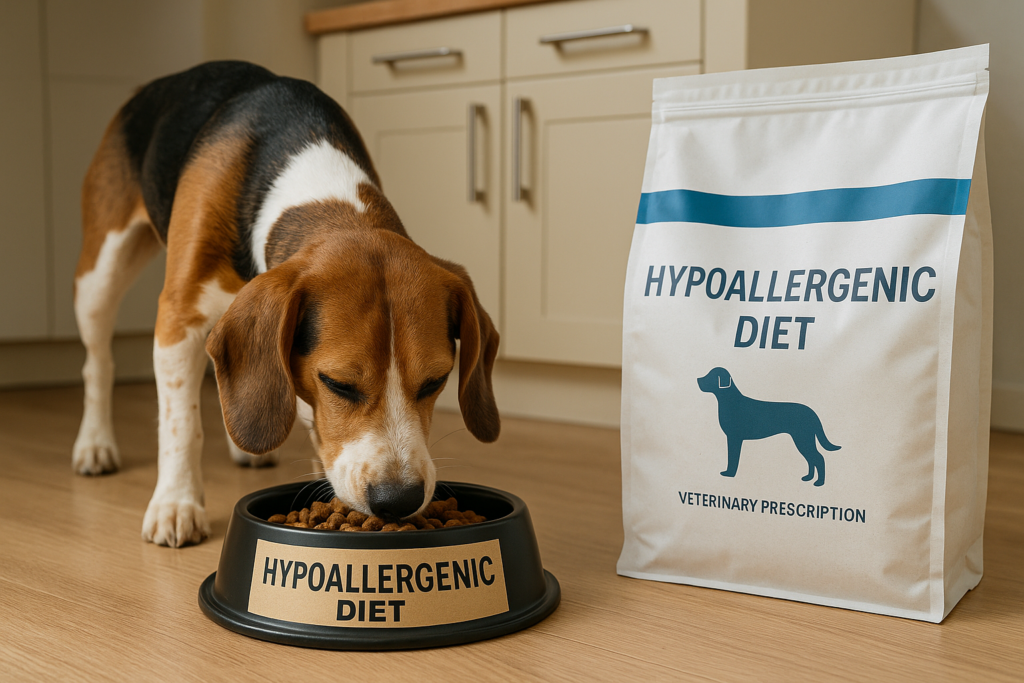
- Feed a high-quality diet that supports skin health—even if food allergies aren’t confirmed.
- Consider adding omega-3 fatty acids (fish oil) daily.
- Keep your dog well-hydrated.
- Ask your vet about skin-supporting supplements.
Monitor Triggers
- Track flare-ups in a notebook or phone.
- Look for patterns tied to seasons, foods, or environments.
- Share these notes with your vet—it can guide long-term allergy care.
With consistent care at home, you can make a big difference in managing dog allergies. Even small daily habits add up to a more comfortable, less itchy life for your pup.
Dog Allergy Treatment Costs in Canada
Managing dog allergies can be a long-term investment. Here’s a look at typical costs for diagnosis and treatment in Canadian veterinary clinics:
| Service or Product | Estimated Cost (CAD) |
|---|---|
| Veterinary exam and skin testing | $100–$250 |
| Flea prevention (monthly) | $20–$50 |
| Hypoallergenic or novel-protein diet | $100–$180/month |
| Apoquel (daily tablet) | $90–$150/month |
| Cytopoint injection (every 4–8 weeks) | $90–$200/injection |
| Medicated shampoo | $30–$60 |
| Allergy blood test | $300–$500 |
| Intradermal skin test (specialist) | $600–$1,000 |
| Immunotherapy (custom allergy serum) | $250–$500/year |
| Supplements (fish oil, probiotics) | $30–$80/month |
Tip: Many dog owners combine insurance and budget-friendly options (like antihistamines or diet changes) to reduce long-term costs. Always ask your vet about alternatives if cost is a concern.
Remember, while dog allergies can be expensive to manage, the right plan can greatly improve your dog’s comfort—and quality of life.
When to See a Vet for Dog Allergies
If your dog shows signs of dog allergies, don’t wait too long to get help. Early treatment prevents discomfort and serious complications.
Signs That Need a Vet Visit
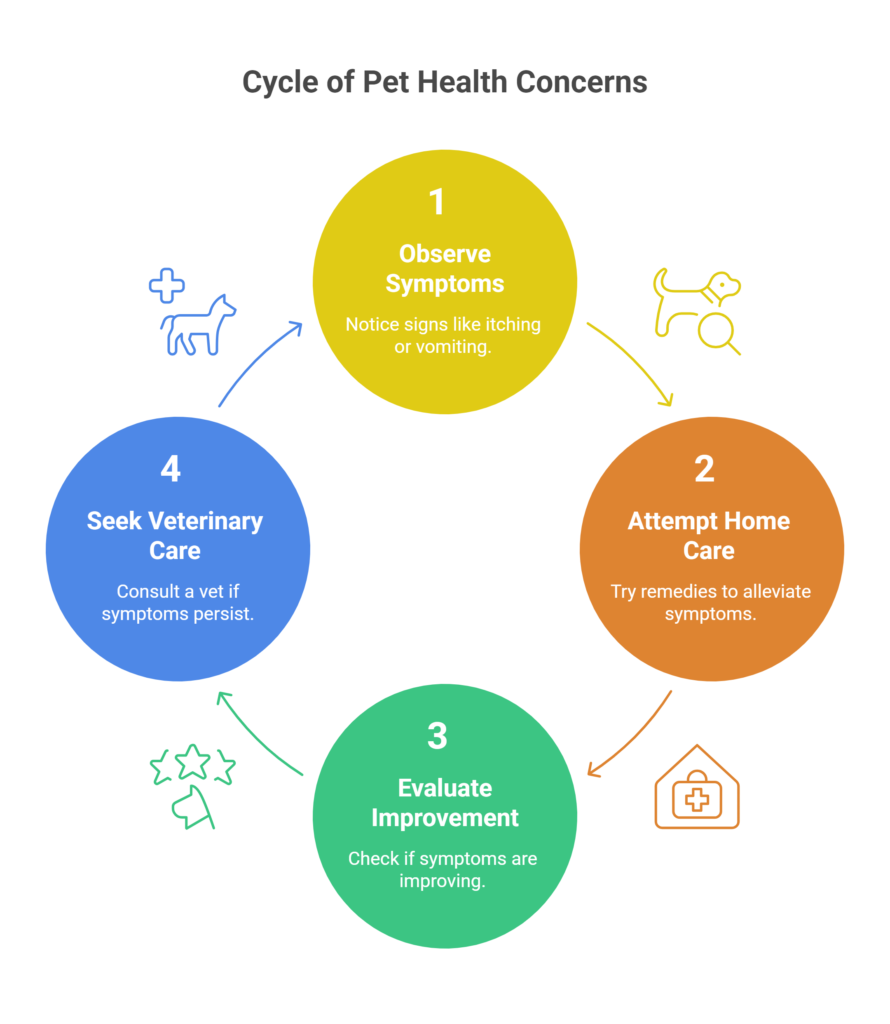
These signs often point to underlying allergies—and your vet can help identify the type and suggest effective treatments.
Signs of an Emergency
- Swelling of the face, lips, or throat
- Trouble breathing or collapse
- Sudden outbreak of hives
- Bleeding sores or hot spots
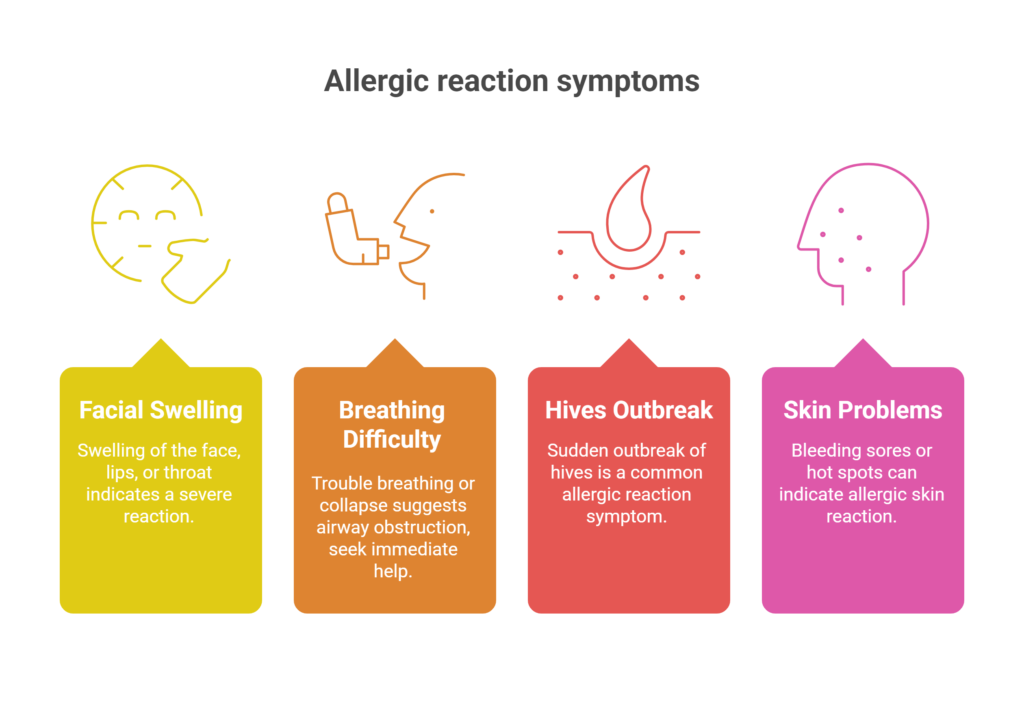
These could mean a severe allergic reaction or infection. Get immediate veterinary care.
Don’t Guess on Your Own
Over-the-counter treatments or food changes without guidance can delay diagnosis. I’ve seen dogs worsen after being put on the wrong diet or misused human meds.
A proper allergy plan starts with a vet exam. With their help, you can get your dog’s symptoms under control and avoid years of frustration.
FAQs About Dog Allergies
Can dogs suddenly develop allergies?
Yes. Dog allergies often appear between 6 months and 3 years of age, but some dogs develop them later. Environmental changes, new foods, or stress can trigger flare-ups.
Are dog allergies seasonal or year-round?
It depends on the allergen. Pollen allergies are usually seasonal, while dust mites or food allergies can cause symptoms all year.
Can food allergies cause ear infections?
Yes. Chronic ear infections—especially with itching or head shaking—are often linked to food allergies. A diet trial can help reveal the cause.
Is Apoquel safe for long-term use?
For most dogs, yes. Apoquel is approved for long-term use and has fewer side effects than steroids. However, it’s not recommended for dogs with certain immune conditions—your vet will advise.
What’s the best food for dogs with allergies?
There’s no one-size-fits-all. Dogs with food allergies often do well on hydrolyzed diets (like Royal Canin Hypoallergenic) or novel proteins (like kangaroo or duck). Always consult your vet before switching.
Final Thoughts on Living With Dog Allergies
Dog allergies can be frustrating—for both you and your pet. But with the right care, your dog can live a comfortable, happy life.
Start by recognizing the signs early: constant scratching, recurring ear infections, or tummy trouble. Work with your veterinarian to find out what kind of allergy your dog has and which treatments will work best.
Most allergic dogs need a combination of care—medications, diet changes, flea control, and home management. It might take time to get things right, but the results are worth it.
I’ve treated dozens of dogs who went from constant misery to full-blown couch-snugglers once we nailed down a plan. Your dog can get there, too.
Be patient, stick with the plan, and don’t hesitate to ask your vet questions. Managing dog allergies is a journey—but it’s one you don’t have to walk alone


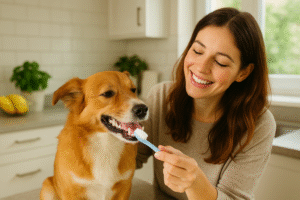

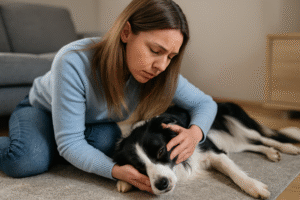
Pingback: The Ultimate Guide to Dog Dental Care: 25 Vet-Approved Tips